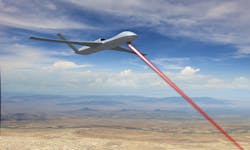Future Optics: Optics and photonics move remotely piloted aircraft forward - an interview with Michael D. Perry
OSA: What got you interested in optics?
Michael D. Perry: I was doing thesis research on nuclear physics at Lawrence Livermore National Laboratory and a couple of attractive opportunities came up in the laser fusion program. I found good folks and interesting projects there, so I switched my research from nuclear physics to quantum electronics. At Livermore, we built the Petawatt Laser to study fast ignition for laser fusion, and it opened a new regime of high-energy density physics to study.When I came to General Atomics 15 years ago, the big problem in increasing the average power from solid-state lasers was extracting waste heat. We had a couple of completely new ideas, including a liquid laser. They were considered crazy at the time, but DARPA funded us and we built the High Energy Liquid Laser Area Defense System (HELLADS), which has produced the highest average power from a solid-state laser (see Fig. 1). It's now used for target experiments at the White Sands Missile Range. We're currently working on a fourth generation of that technology, reducing laser size and weight, and improving its beam quality and electrical power conversion efficiency.
OSA: What other optical systems are you working on?
MDP: The principal focus of GA-ASI is the development and production of remotely piloted aircraft (RPA) systems, along with electro-optical and infrared systems for intelligence, surveillance, and reconnaissance. Our synthetic electro-optical/infrared (EO/IR) capability is in greatest demand. The EO/IR system on our RPA goes far beyond GoPros—it is a sophisticated system with capabilities including multispectral imaging and laser designation. Hyperspectral and wide-field imaging, as well as lidar, also are growing interests.
RPA is becoming ubiquitous. We build them for the U.S. Air Force for use on the MQ-9 Reaper as well as for the Royal, Italian, and French Air Forces, but they have many civilian uses, too. Newer versions can fly for over 30 hours to collect high-resolution images to aid civilian disaster relief and emergency services. NASA has flown its Predator B RPA over California wildfires to identify fire fronts and look for new hot spots so firefighters can position their resources most effectively. The Department of Homeland Security has a number of them around the country for use in emergency situations.
Another example of RPA emergency response was in North Dakota a few years ago, where floods were followed by a freeze. An ice dam blocked one of the main rivers in the region, and emergency responders on the ground couldn't tell what was going on. Our radar and optical imagery helped pinpoint how to break up the ice dam and ease the flooding (see Fig. 2).OSA: How else are these systems being used?
MDP: Foreign governments are looking to use them for border surveillance and to monitor pipelines and other infrastructure such as bridges, roadways, and waterways. Finding anomalies quickly is a big deal. Back in May 2015, an oil pipeline broke near Santa Barbara, causing a major oil spill. It turned out that the pipeline had been leaking slowly for five months before it finally broke. If you had spotted the leak when it was small, you could have fixed it quite easily, with minimal environmental damage. No RPA could have prevented the Deep Horizons spill in the Gulf of Mexico, but high-resolution imagery of the evolving oil slick could have improved containment.
Another type of environmental monitoring is looking at the spectral signatures of crops or other vegetation for signs of distress from drought or pest infestations. Flying RPA costs much less than ground-based monitoring, and are more precise. Monitoring can identify under- or over-watering, and those are big deals in the current California drought.
In the Arctic, a hot topic is monitoring ice flow as global warming breaks up the ice sheet. Ice flow is dynamic. If you're shipping through the northern passage that opens in the summer, you have to plot it continually as the ice moves to ensure that your ship doesn't get stuck. This is a unique opportunity for RPA.
OSA: How are government regulations affecting autonomous vehicles?
MDP: The new FAA rules limit small drones to flying below 500 ft. Our aircraft are large and the real issue for them is flying in national airspace. Rules have yet to be announced, but it's clear that they need a sense-and-avoid capability to fly there. We've developed a radar-based approach, but others are looking at optical technologies. They must cover a large range—our aircraft can go up to 50,000 ft. The European countries and Japan also are looking at regulations for flying RPA in national airspace.
OSA: What about non-imaging optics on UAVs?
MDP: One of interest right now is laser communications. The big advantage of laser systems is gigabit data rates, compared to tens of megabits with radio-frequency systems. The challenges are avoiding interference from the weather and keeping beams pointed to high accuracy to and from the aircraft, but those issues can be overcome. The technology is very sound and can easily get to 2 Gbit/s. The European Alphasat includes a laser communications terminal, and we're working with the Alphasat partners to demonstrate a link between it and our RPA lasercom unit.
Google and Facebook are working on using large RPA like ours as servers in the sky to hover over rural areas. Mark Zuckerberg famously said that Africa has a billion potential Facebook users with no connection to the Internet. He can't run a hundred thousand miles of wire, but he can use lasercom to deliver the Internet from RPA at high capacity.
OSA: What advice do you offer young professionals about opportunities in optics?
MDP: There are tremendous opportunities in RPA-based optical systems, and lasers and electro-optics as a whole. We're desperate for good people. There is a lot of competition between the aerospace industry and companies like Google and Facebook that are developing their own optical systems. Anybody fresh out of school, or with a little experience in optics and lasers, is in high demand.
ACKNOWLEDGEMENT
Avenger and Lynx are registered trademarks of General Atomics Aeronautical Systems, Inc. (GA-ASI).
MICHAEL D. PERRY is vice president of laser and electro-optic (LEO) systems for the Mission Systems business unit of General Atomics Aeronautical Systems, Inc. (GA-ASI), where he is responsible for development of electro-optic, laser, and missile defense systems for manned and remotely piloted aircraft (RPA) systems. He earned his doctorate from the University of California at Berkeley in 1987. He is a fellow of The Optical Society, with more than 30 patents on the development and use of lasers. He is a DOE Nuclear Science Fellow and was awarded the Nuclear Weapons Excellence Award.


